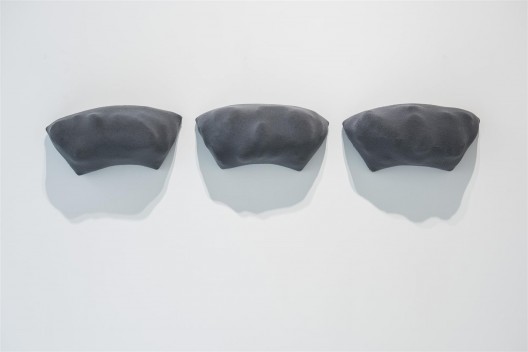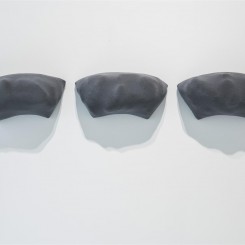This piece is included in Ran Dian’s print magazine, issue 2 (Winter 2015–2016)
“Pittura”—Pino Pinelli solo exhibition
Pearl Lam Galleries (No. 1, G/F & 1/F, SOHO 189, 189 Queen’s Road West, Sheung Wan, Hong Kong), Sept 18–Oct 13, 2015
“I cannot possibly understand those artists who place themselves in front of the canvas as if it was a surface to be filed up with colors and shapes, following a taste that is more or less appreciable. They trace out a sign, walk a few steps back, look carefully at what the have just done, bend their head, half close their eyes, then jump forward and start again. They go with this sort of physical training until they have filled up the canvas completely. In this case a surface if endless possibilities is now reduced to a sort of receptacle in which artificial colors and meanings are compressed. Why do they not empty out this receptacle? Why don’t they set this surface free? Why do they not investigate the endless meaning of a total space, of a pure and absolute light? …” – Piero Manzoni
The space of painting is one which has been continually challenged since the advent of Modernism. With the arrival of abstraction, painters and painting sought ways to challenge the age-old notion of arranging color and form on a surface to reach a state in which a recognizable space has been communicated. Once elements such as narrative, perspectival depth and illusionism were sufficiently abandoned, soon enough color, emotion, and hierarchical distinctions in the picture plane had to go as well. Ad Reinhardt claimed that in painting his black paintings, he was “making the last paintings which anyone can make.” This linear trajectory seemed to imply that art had to move off the canvas altogether in order to progress. Yet painters continue to grapple with the meaning and significance of painting as we speak, and take what they need to from the language and history of painting in order to carve out an individual vision. The painter Albert Oehlen once said that “as long as painting’s refutation can still take the form of painting, painting has not been refuted.”

皮诺·皮奈利,《画GR》,混合媒介,每件10.5 × 20 cm,1987 / Pino Pinelli, “Pittura GR”, mixed media, 10.5 × 20 cm each, 1987
The Italian artist Piero Manzoni, whose statement opens this review, was a pioneering figure in the movement of artists coming to terms with painting in ways alien to traditional painting. His Achromes, all-white gessoed surfaces stuffed with Kaolin, were a solution to the problem of how to arrive at something new and pure. Pino Pinelli, an artist born in 1938 in Catania, Sicily, was of a generation of “Analytical Painting,” a loosely-defined tendency of painters who had witnessed the achievements of Manzoni, as well as temporally and philosophically related artists including Lucio Fontana and the Zero Group of Germany, and, finding sources of inspiration in these artists, had to reckon with what they had done to find a voice for themselves. Pinelli’s intensive reflection on his practice and research into materials eventually led to a deeply personal and meditative exploration of painting spanning nearly half a century. His work is presented as a solo exhibition for the first time in Asia in “Pittura”, on view at Pearl Lam Galleries Hong Kong SOHO from 18 September to 13 October, 2015.
The exhibition, which takes up two floors of the gallery space, covers forty years of work, which begins here with the sole painting on canvas, “Pittura R”, from 1974. A monochromatic red field seen from afar, it is once the painting is approached for the closer view which activates a pulsating network of dots in a red slightly lighter than that of the main ground. Despite a surface minimally inflected by the painter’s hand, the painting nonetheless gives off an vibrant optical charge, sending one into a paradoxically pleasant disorientation when the eye attempts to detect patterns or movements between the dots yet focus keeps getting resisted and pulled back into the deeper red ground. Step even closer to the painting, and the dots begin to fade, leading to a seemingly uniform red surface whose only nuances are highlighted by the rough, uneven texture of the canvas weave. With this single work, Pinelli has established a series of painterly concerns which would preoccupy him for the next several decades, namely figure/ground tension, material presence, and the outlining of a deep optical space achieved through monochromatic color.
The next work in the timeline of the exhibition is “Pittura 86” from 1986, and in this mature piece Pinelli has arrived at the format which he has tirelessly explored in serial manner up to the present: a configuration of separate but identically repeating monochromatic shapes of wool-like fabric which at first appear to bear resemblance to Donald Judd’s “specific objects,” things which lie somewhere in the middle of the continuum between painting and sculpture. Yet Pinelli’s works are firmly grounded in the concerns and presentation of painting; their presentation is lent a picture-like resonance. The entire first floor of the show is devoted to works of the color red, while the second floor features all grey works save for a single red piece. That Pinelli titles every work “Pittura”, with an R or GR afterwards to connote red or grey, emphasizes the rational, conceptual motive behind their creation. However, there remains an inescapable poignancy to these fabrics: the shapes and configurations are often almost evocative of things seen in the world, such as flowers, eyes, a window, clouds, cobblestones or raindrops, yet they also resolutely defy naming and remain themselves. This ideological push-pull is echoed in their physicality; some shapes repeat themselves from red to grey, while others undergo slight variations across colors. The monochromatic nature of these works enables a heightened perception towards the details of the installation. The negative space in between shapes, and the shadows cast on the wall surrounding a piece work together to introduce an element of ambiguity as figure and ground, as well as foreground and background, become interchangeable upon a refocusing of the eyes. In privileging the act of seeing, through looking at an outside thing and also turning one’s gaze inward, and maintaining a curiosity towards the probing of a form’s limits, Pinelli has developed a constantly multiplying and shifting painterly space that rewards repeated scrutiny and reflection.
[1] Karsten Schubert LTD: Piero Manzoni, works 1957–1961,1989, page 5


